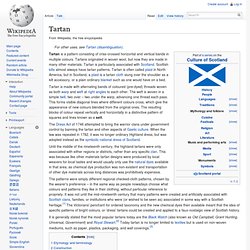

Tartan. Tartan is a pattern consisting of criss-crossed horizontal and vertical bands in multiple colours.

Tartans originated in woven wool, but now they are made in many other materials. Tartan is particularly associated with Scotland. Scottish kilts almost always have tartan patterns. Tartan is often called plaid in North America, but in Scotland, a plaid is a tartan cloth slung over the shoulder as a kilt accessory, or a plain ordinary blanket such as one would have on a bed. The Dress Act of 1746 attempted to bring the warrior clans under government control by banning the tartan and other aspects of Gaelic culture. Until the middle of the nineteenth century, the highland tartans were only associated with either regions or districts, rather than any specific clan. Etymology and terminology[edit] List of U.S. state tartans. Strathmore Woollen Company. Another school of thought suggests that the word tartan is derived from the Spanish word tartana, which referred to fine quality cloth, and few would dispute that today’s Scottish tartan is indeed a cloth of particularly fine quality.
There is no doubt however, that a number of different tartans have existed in Scotland for centuries, or that these were loosely associated with different areas, as this was being regularly recorded by travellers in Scotland by the 16th Century. Although the earliest piece of checked, tartan-like cloth found in Scotland dates from around 325AD however, its development from then until the 16th Century is largely unclear. By this time, the use of wool as the yarn for weaving tartan was firmly established. This would have been spun on a spinning wheel, dyed with natural vegetable juices to give the traditional ‘old colours’, and then woven by hand to make the different tartans in use at that time. Scottish Tartans Authority. Until relatively recently, it was assumed by most historians, academicsand commentators that tartan was a Johnnie-come-lately . . . a modern invention by rapacious 19th & 20th century weavers and city merchants eager to swell their coffers.
Rumours abounded of much earlier origins but it wasn't until American textile archaeologist Elizabeth Barber thoroughly investigated the Mummies of Ürümchi that the real truth emerged - backed up by impeccable archaeological proof. We are greatly indebted to Elizabeth Wayland Barber's fascinating book "The Mummies of Ürümchi" (ISBN 0-393-04521-8) from which we have unashamedly borrowed parts of the text and diagrams. This book is a 'must' for anyone interested in textile history of this area and era. The famous mummies of Egypt appear dry and shrivelled, blackened like discarded walnut husks, compared with these lifelike remains. The bright colours had amazed us and delighted us . . . Www.users.zetnet.co.uk/tartan/history.htm. Today, books or shops dealing with tartan and Highland Dress will be mainly, if not exclusively, concerned with clan tartans.
They may seek to suggest that these are the actual patterns worn by the Scottish clans throughout history up to, and including, the Battle of Culloden in 1746. This is not the case. The majority of the pre-1850 patterns bearing clan names can only be traced back to the early 19th century and to the famous weaving firm of William Wilson & Sons of Bannockburn, near Stirling. History of the Tartan. Introduction Tartan, arguably the best-known cloth in the world, is not peculiar to Scotland, although it has become the country's national costume, occupying a unique place in its history, and in the hearts and minds of millions of Scots. The History of Scottish Tartan & Clan Tartans, Scotland - UK History. If the concept of clan tartans was born at Culloden it wasn't universally known - in that battle there was frequently no way of differentiating friend from foe by the tartan he wore.
The only reliable method was to see with what colour ribbon - sprig – a bit of plant - each combatant had adorned his bonnet which, would differ to show the affiliation to ones Clan. This represented in Scottish Heraldry today as a ‘Plant Badge’ that would be worn by a follower to show loyalty to ones Chief. There is a contrary view that this was caused, not by the lack of clan tartans, but by the Highlander's propensity for discarding his cumbersome philamhor (belted plaid) before charging into the fray. Scottish Tartans Authority. The Scottish Register of Tartans. Scottish Tartans Museum. Index to Scottish Tartans, Irish Tartans, Welsh Tartans, Canadian Tartan, Clan Names. Scotland’s gift to the world. Tartan Designer - Tartan Maker - Tartan Background pattern generator. Tartan Fabrics Kilts Tartan Ribbon in Any Tartan Scottish.
Scottish Tartans & Tartan Fabrics by Scotweb Kilt & Tartan Store. Scottish tartans-Scotland clans heritage from Scotland On Line. April 6 - Scotland's Tartan Day. Tartan Day Scotland Festival 2014 - 5 to 13 April Tartan Day marks the signing of the Declaration of Arbroath in 1320 at Arbroath Abbey. This historical occasion sowed the seeds of modern day democracy and was used as a basis for the American Declaration of Independence. Tartan Day was inspired by this historical occasion to celebrate all that is good about Scotland - its people, its heritage, its history, its culture and its amazing legacy to the world.